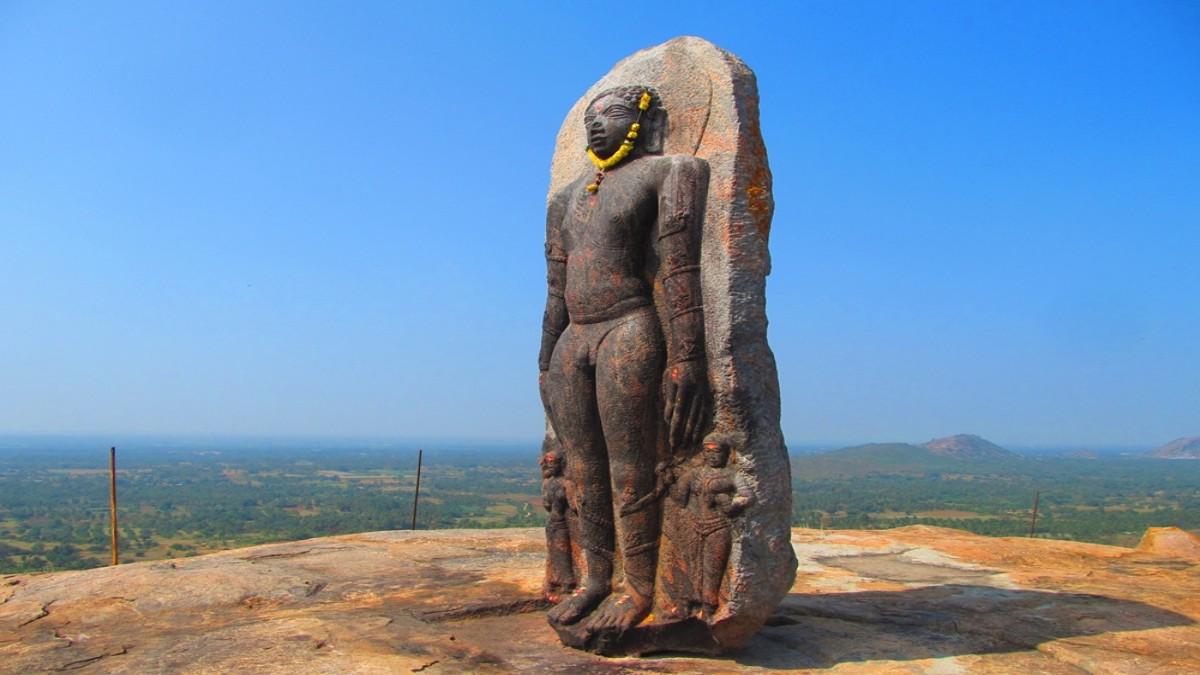Think of Bahubali – not the movie, but the revered Jain figure – and what comes to mind is the colossus standing at Shravanabelagola. While having pride of place, it is well known that this is not the only Bahubali icon in Karnataka, with others in Karkala (Udupi district), Dharmasthala and Venur (Dakshina Kannada) as well as Gommatagiri (Mysore).
While all these sites, being focal points of temple complexes, are pilgrim destinations, there is one more site where a Bahubali stands. In isolation atop a rocky hill 81 kms north-east of Mysore and 93 south-west of Bangalore, Arethippur is ‘technically’ not a remote place. It just happens to be one of those tiny enclaves that time forgot and did an even better job at hiding.
Though locally known for long, the hilltop Bahubali came into the limelight only in the 1980s when the first organised exploration took place at a related site close to the base of the hill. Excavations have revealed that Arethippur was once a thriving Jain centre known as Tippuru. Established in the 8th century CE by the Ganga dynasty, it remained a place of significance even during the Hoysala period of the 12th century CE.
The excavations have focused on Kanakagiri, a mound that lies outside the currently inhabited village. The site has thrown up the remains of a dozen temples, built and added over time. Surrounding the temples of Kanakagiri was a fortified wall which no longer exists – this was perhaps a protective enclosure for the shrines. There is also a deep trough cut into the rock, serving as a water body for the ritual needs of Jain monks. Near this water body are several carved Tirthankara figures, including some incomplete ones. Were those who were carving these icons disrupted in their task by an external attack? The answer to that remains unknown.
What has been recognised is the importance of the place. ‘Tippuru’ has been mentioned in several inscriptions found here and elsewhere. At the site itself, a Hoysala inscription was found that spoke of the grant of Tippuru by a Hoysala general named Gangaraja to a Jain teacher called Meghachandra Siddhantadeva. The date corresponds to December 25, 1117. Continuing digs at the site gradually reveal more of its past.
Impact Shorts
More ShortsBut the object of this story is not in the excavated site but on a hill that overlooks the place. Looking up at the hill from the excavated site, a small dark object is visible at its peak. A short drive on a rough track brings a visitor close to the hill. After that, the journey has to be completed on foot. And true to the spirit of a pilgrimage, the going is rough, with the pathway being rocky and steps extending only part of the distance. At one point, a visitor needs to pass via a narrow space between two huge boulders. Clearly, this is not a trip for those looking for an easy passage.
The persistence and faith are richly rewarded at the top. And not just by the spectacular views. The Bahubali icon is magnificent – a monolith carved on a black rock and standing over ten feet in height. Depicted at its feet are two female forms and curling on its hands and legs are creepers of the forest in which Bahubali stood in prayer, as per Jain epics.
According to scholars, the Bahubali at Arethippur dates to the 9th century CE period, making it much older than the more famous one at Shravanabelagola. One wonders if it inspired, or even acted as the prototype, for the famed monolith of Lord Gomateshwara. Who knows, one day an inscription may be found mentioning a visit to Arethippur by Chavundaraya, the man who commissioned the Shravanabelagola icon.
In a heart-warming initiative, the Jain community at Shravanabelagola has also played an active role in reviving the site. In 2017, a Mahamastakabhisheka ceremony was conducted at Arethippur, during which the monolith was anointed with sacred liquids. A Bhattaraka – head of a religious institution such as a monastery – is also said to have been appointed here.
More than eleven centuries after it was created, the Bahubali monolith still stands upright and in doing so, appears to dominate the landscape of Arethippur. Spreading below is a carpet of fields, punctuated by clumps of trees and of course, a white-coloured patch where the archaeological excavation continues to surprise history buffs.
The author is a heritage explorer by inclination with a penchant for seeking obscure sites. A brand consultant by profession, he tweets @HiddenHeritage. Views expressed in the above piece are personal and solely those of the author. They do not necessarily reflect Firstpost’s views.
)